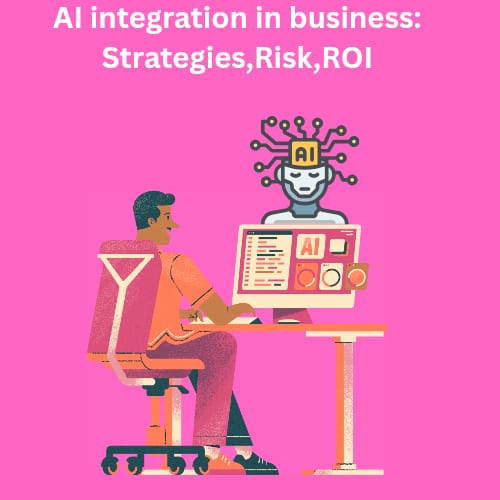Integration of AI in Business: Strategy, Risk & Return on Investment
Integration of AI in Business: Strategy, Risk & Return on Investment
Integration of AI in Business: Strategy, Risk & Return on Investment
Imagine this—you have a shop. Hundreds of customers are coming every day. Someone is buying milk in the morning, someone is picking up chips in the afternoon, and someone else is doing big shopping at night. Do you know who is buying what at which time, why they are buying, and what they might buy in the future?
Or imagine you are running a hospital. At 2 a.m. a patient asks a question online—“Why is this number higher in my report?”—if an intelligent system could instantly answer, how amazing would that be!
The name of this magic is Artificial Intelligence or AI.
AI means a technology that can learn like humans, think, make decisions, and even create new solutions.To survive in today’s business competition, AI is no longer a luxury—it is an absolutely essential tool. Why is AI essential in business now?
The business of the 21st century is standing before three main challenges:
- How to reduce costs?
Every organization wants to cut unnecessary expenses.
- How to make the customer happier?
To stay alive in a competitive market, customer experience is the greatest treasure.
- How to handle future risks?
Market changes, economic recession, or new competitor pressure—you must be prepared for everything. AI is that tool which can answer all three questions at the same time.
Examples:
Amazon: Using AI to analyze customer browsing history, it predicts who might buy what. As a result, sales increase significantly.
Strategy for Using AI in Business
To use AI successfully, planning is needed. Using it randomly can cause damage instead. Below are step-by-step strategies—
- Define the Goal
AI is not a fashion. So first decide—why do we want to use AI? To increase sales? To speed up customer service? To reduce costs? Or to understand market trends?
Example:
A supermarket wants to know through AI which products sell more in which season.
A small clinic wants to manage patient appointments through AI.
- Data is the Fuel
AI cannot function without data. Customer buying habits, seasonal sales patterns, competitor information—all of these are AI’s “food.” Good data makes AI predict accurately. Bad data gives bad results.
Example:
A food delivery app utilizes AI to watch which locality orders burgers more at lunch, and pizzas at night.
- Technology & Frameworks
To run AI, the right technology is needed. Hardware (servers, computers) Software (machine learning tools, cloud services) Infrastructure (data storage, security) The question is—should the old system be modernized, or should a brand-new system be built?
- Skilled Workforce
No matter how intelligent AI is, it needs people to run it. Data scientists, Software engineers, Business analysts, Regular employees who know how to use AI
Example:
A bank started using AI for loan approvals. But if employees don’t know how to read AI reports, it will be of no use.
- Start Small
You shouldn’t jump into a huge project with AI immediately.
Start small, such as: Chatbots in customer care, Auto-ad targeting in marketing, Demand forecasting in stock management, Then gradually expand to bigger areas.
- Morality & Transparency
When AI is used, customers should know—are they talking to a human or a machine? Transparency builds trust.
Example:
If a company clearly states—“This answer was given by our AI”—the customer will not feel deceived.
Risks & Challenges of using AI:
Using AI doesn’t solve everything. Some big challenges must be kept in mind.
- Quality of Data
If data is biased, decisions will also be biased.
Example:
If AI sees male candidates are preferred in recruitment data, it will also give fewer opportunities to female candidates.
- Cybersecurity
AI means lots of data, and lots of data means a target for hackers.
Example:
If a hospital’s patient data falls into hackers’ hands, it can cause severe damage.
- Job Risk
AI will reduce some old jobs.
Example: data entry, telecall center
But it will also create new jobs.
Example: AI trainers, data analysts
The question is—are workers prepared for that change?
- Initial Cost
Running AI projects requires infrastructure, software, and experts—all of which cost a lot. Particularly in small businesses, this is a big barrier.
- Moral & Lawful Questions:
If AI decides—who will get a loan and who will not—will that always be fair?
his is where ethical and legal complications arise.
Return on Investment (ROI)
The biggest question about AI: “What’s my profit in this?”
By using AI you can reduce cost, increase productivity, gather customer satisfaction, find new oppurtunities, Make sustainable profit margin.
Some Simple Examples
Shop: AI analyzes which products sell more at which time → reduces hassle of overstocking or understocking.
Service organization: AI chatbot gives 24/7 customer support → reduces employee pressure.
Small business: Social media ads targeted with AI → costs less, sales increase.
Future Possibilities
How AI can transform business in the future—Fully automated customer service. Data-driven personalized marketing. Advanced fraud detection technology. Sustainable business practices (energy saving, resource management)
Conclusion
Today AI is not just a technology in business—it is a survival strategy. With proper planning, it reduces cost, increases revenue, and makes customers happy. With wrong planning, it can become a source of risk. So, for using AI you need—Clear goals, Quality data, Skilled workforce, Ethics & transparency
Finally, it can be said—AI is the guiding light of business in the future.
Now the question is—are you ready to welcome AI into your business?
Popular Tools
Recent Posts






